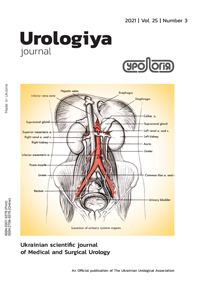False cryptorchism as a cause of hormonal disorders and fertility disorders in men
DOI:
https://doi.org/10.26641/2307-5279.25.4.2021.253393Keywords:
false cryptorchidism, hypogonadism, male infertility, testosterone, fertilityAbstract
We during 2012–2021 in the urology clinic of the DSMU on the basis of the KP “Dnepropetrovsk Regional Clinical Hospital named after I.I. Mechnikov Dnepropetrovsk Regional Council“ in 124 patients with false cryptorchidism aged 18 to 62 years (average 28.7±8.3 years), who consulted about fertility disorders, hormonal levels, erectile dysfunction, a comprehensive examination was carried out, conservative (28 patients – control group) and surgical (96 – main group) treatment.
All patients with false cryptorchidism underwent a comprehensive examination. The examination of patients included the study of complaints, medical history and life. At the same time, the timing of the formation of complaints, the presence of chronic diseases, bad habits (smoking) were clarified.
A physical examination was performed to assess the function of all organs and systems and to identify concomitant pathology. The local status of the patient was assessed in an upright and horizontal position at rest, with tension and coughing. Changes were assessed when examining the external inguinal ring.
Laboratory studies were carried out in all patients in the following volume: clinical blood test; biochemical blood test with the determination of indicators of levels of total protein, urea, creatinine, bilirubin, liver enzymes, glucose; determination of the level of blood hormones (LH, FSH, total testosterone, estradiol, prolactin, cortisol); assessment of spermatogenesis (spermogram).
All patients, in accordance with the criteria for inclusion in the examination and surgical intervention, underwent ultrasound of the scrotal organs with Doppler ultrasound, both in order to clarify the structural state of the testicle and to determine the size, calculating the volume of the testis, the presence of excess fluid in the intershell space, the state of arterial and venous circulation, the presence of a positive or negative Valsalva test.
All patients who were involved in the study (main and control groups) received conservative therapy (wobenzym, 5 tablets 3 times a day for 1–2 months, vitamin E preparations, 200 mg 3 times a day, 2 months and ascorutinum 1 tablet 3 times a day – 1 month In patients with significantly reduced testosterone levels, the therapy included tribestan 2 tablets 3 times a day for 3 months.
Patients who agreed to undergo surgery received the above therapy after surgery. Surgical treatment consisted of plastic surgery of the inguinal canal according to the Zirard–Spasokukotsky method modified by Kimbarovsky on one (with unilateral) or two sides (with bilateral false cryptorchidism).
The obtained results of postoperative treatment in comparison with the results of the initial examination indicate an improvement in the indicators of hormonal examination and the results of spermogram. In the control group, which received only conservative therapy, the changes in indicators were not evidence-based.
When examining patients with infertility and erectile dysfunction when pathological testicular migration is detected, it is necessary to consider the possibility and necessity of surgical treatment in order to prevent further suppression of spermatogenic and hormonal function in these men and restore hormonal levels and fertility.
Since pathological changes in false cryptorchidism lead to the occurrence of, in addition to infertility, metabolic syndrome and hypogonadism, this problem is very important in maintaining male health.
References
Абубакиров А.Н. Повреждения ДНК сперматозоидов и мужское бесплодие. Урология. 2009. № 3. С. 86–91.
Горпинченко И.И. и др. Мужское бесплодие: этиология, патогенез, классификация, диагностика и методы лечения. Днепр: ООО «Акцент ПП», 2016. 344 c.
Горпинченко І.І., Нуріманов К.Р., Сайдакова Н.О. Чоловіче безпліддя в Україні: статистика та тенденції. Чоловіче здоров’я. 2012. № 4.
Диагностика мужского бесплодия. Справочник поликлинического врача. 2021. № 2. C. 61–64.
Зиганшин О.В., Безпалко Ю.В., Ковалев Ю.Н. Эффективность применения препарата витапрост у пациентов с бесплодием, развившемся на фоне хронического простатита. Урология. 2010. № 6. C. 50–54.
Лучицкий Е.В., Бондаренко В.А. Избранные лекции по клинической андрологии: монография. Киев–Харьков, 2010. 144 c.
Имшинецкая Л.П., Нуриманов К.Р., Добровольская Л.И. Гормонотерапия в комплексном лечении мужского бесплодия. Здоровье мужчины. 2012. Т. 42, № 3. C. 121–123.
Інформаційно-статистичний довідник про допоміжні репродуктивні технології в Україні. Київ: 1, 2021. 24 c.
Лопаткин Н.А. Руководство по урологии. М.: Медицина, 1998. Т. 2. C. 50–54.
Ошикбаев К.П., Абылайулы Ж., Дукенбае-ва Б. Взаимосвязь мужского бесплодия с избыточной массой тела. Урология. 2009. № 6. C. 43–48.
Рутинский А. Особенности диагностики идипатичского мужского бесплодия. Медико- социальные проблемы семьи. 2013. Т. 18, № 1.
Тиктинский О.Л., Калинина С.Н., Михайличенко В.В. Андрология. М.: ООО «Мед. информ. агентство», 2010. 576 c.
Hamilton J. B., Hubert G. Differential diagnosis of pseudocryptorchidism and true cryptorchidism. Endocrinology. 1937. Vol. 21, No. 5. P. 644–648. Doi: 10.1210/endo-21-5-644.
Downloads
Published
Issue
Section
License
Стаття повинна мати візу керівника та офіційне направлення від установи, з якої виходить стаття (з круглою печаткою), і вказівкою, чи є стаття дисертаційною, а також у довільній формі на окремому аркуші - відомості про авторів (прізвище, ім’я, по батькові, посада, вчений ступінь, місце роботи, адреса, контактні телефони, E-mail).
Стаття повина бути підписана всіма авторами, які укладають з редакцією договір пропередачу авторських прав (заповнюється на кожного автора окремо з оригінальним підписом). За таких умов редакція має право на її публікацію та розміщення на сайті видавництва.

